Environment-Friendly Biodiesel/Diesel Blends for Improving the Exhaust Emission and Engine Performance to Reduce the Pollutants Emitted from Transportation Fleets
Abstract
1. Introduction
- To produce microalgae, jatropha, and polanga biodiesel using acid–base transesterification;
- To assess and compare engine characteristics (performance, combustion, and emission characteristics) of microalgae (MB10 and MB20), jatropha (JB10 and JB 20) and polanga (PB10 and PB20) with base fuel, i.e., commercial diesel fuel;
- To compare third-generation biofuels (MB10, MB20) with second-generation biofuels (JB10, JB20, PB10 and PB20).
2. Materials and Methods
2.1. Production of Microalgae, Jatropha and Polanga Biodiesel
2.2. Physico-Chemical Properties of Fuel Blends
2.3. Engine Experimental Test Setup and Procedure
2.4. Heat Release Rate Determination
3. Results and Discussions
3.1. Comparison of Performance Characteristics of the Engine with Different Fuel Blends
3.2. Comparison of Combustion Characteristics of the Engine with Different Fuels
3.3. Comparison of Emission Characteristics of the Engine with Different Fuels
4. Conclusions
- The BTE of the engine decreased slightly with all the tested biodiesel blends (MB10, MB20, JB10, JB20, PB10, and PB20) in comparison to base diesel fuels at all loads, due to the lower calorific value, higher density, and viscosity of the biodiesel blends. However, this slight increase in the efficiency is insignificant under uncertainty limits.
- Lower in-cylinder pressure and heat-release rates were observed with the biodiesel blends due to slow oxidation reaction rates at low combustion temperatures. At 100% load, the in-cylinder peak pressure decreased from 63.3bar with base diesel to 57.7, 60.9, 62.41, 62.37, 63.3, and 63.5 bar for D100, MB10, MB20, JB10, JB20, PB10, and PB20 fuel blends at 100% load.
- All carbon-based emissions (hydrocarbons: HC, carbon monoxide: CO) decreased with increasing biodiesel blending share at all loads. This reduction was at higher rate at higher loads than lower loads. The HC emission decreased about 2.1%, 9.8%, 1.9%, 8.1%, 1.0%, and 7.5% for MB10, MB20, JB10, JB20, PB10, and PB20, respectively, at lower load. Similarly, engine-out CO emissions with MB10, MB20, JB10, JB20, PB10, and PB20 fuels decreased by 3.2%, 7.0%, 1.5%, 7.1%, 6.8%, and 5.2% relative to neat diesel fuel.
- NOx emission increased with all the tested biodiesel blends as compared to base diesel fuel at all loads due to the dominant effect of oxygen content. However, NOx emissions can be reduced significantly using engine after-treatment technologies such as selective catalytic reduction.
- Smoke emissions were found to be decreased marginally with increasing biodiesel blending share at all loads. At rated load, the smoke emission decreased from 58% opacity with base diesel fuel to 55%, 53%, 58%, 56%, 56%, and 54% opacity with MB10, MB20, JB10, JB20, PB10, and PB20 fuels respectively.
Author Contributions
Funding
Conflicts of Interest
>Nomenclature
| Partial differential of calculated parameter q which depends on different measured variables x1, x2,…,xn. | |
| Mass flow rate of fluid/species/fuel, kg/s | |
| Universal gas constant, J/mol-K | |
| MB | Microalgae-biodiesel |
| ASTM | American Standard Testing Method |
| BSFC | Brake specific fuel consumption, kg/kWh |
| BTE | Brake thermal efficiency, % |
| CHRR | Cumulative heat release rate, J/cycle |
| CI | Compression ignition |
| CO | Carbon monoxide |
| D | Diesel |
| Fspecies | Mole fraction of exhaust gas species (CO, HC and NOx) |
| FFA | Free fatty acid |
| HC | Hydrocarbon emission, g/kWh |
| HRR | Heat release rate, J/⸰CA |
| JB | Jatropha-biodiesel |
| MW | Molecular weight |
| N | Engine speed, rpm |
| NDIR | Nondispersive infrared |
| NOx | Oxides of nitrogen, g/kWh |
| p | In-cylinder pressure |
| P | Rated power, kW |
| PB | Polanga biodiesel |
| Q | Heat release rate, kJ |
| R | Characteristic gas constant |
| T | Temperature, K or oC |
| U | Internal energy, J |
| Degree crank angle |
References
- Patel, A.; Arora, N.; Sartaj, K.; Pruthi, V.; Pruthi, P.A. Sustainable biodiesel production from oleaginous yeasts utilizing hydrolysates of various non-edible lignocellulosic biomasses. Renew. Sustain. Energy Rev. 2016, 62, 836–855. [Google Scholar] [CrossRef]
- Scarlat, N.; Dallemand, J.-F.; Monforti-Ferrario, F.; Banja, M.; Motola, V. Renewable energy policy framework and bioenergy contribution in the European Union–An overview from National Renewable Energy Action Plans and Progress Reports. Renew. Sustain. Energy Rev. 2015, 51, 969–985. [Google Scholar] [CrossRef]
- Scarlat, N.; Dallemand, J.-F.; Monforti-Ferrario, F.; Nita, V. The role of biomass and bioenergy in a future bioeconomy: Policies and facts. Environ. Dev. 2015, 15, 3–34. [Google Scholar] [CrossRef]
- Purohit, P.; Dhar, S. Biofuel Roadmap for India, Promoting Low Carbon Transport in India; UNEP DTU Partnership (United Nations Environment Programme); 2015; Available online: https://backend.orbit.dtu.dk/ws/portalfiles/portal/120569025/Biofuel_Roadmap_for_India.pdf (accessed on 1 October 2015).
- India’s Intended Nationally Determined Contribution: Working Towards Climate Justice; United Nations Framework Convention on Climate Change (UNFCCC), Bonn. Available online: http://www4.unfccc.int/submissions/indc/published%20documents/india/1/india%20indc%20to%20unfccc.pdf (accessed on 1 October 2015).
- Maranduba, H.L.; Robra, S.; Nascimento, I.A.; Da Cruz, R.S.; Rodrigues, L.B.; De Almeida Neto, J.A. Improving the energy balance of microalgae biodiesel: Synergy with an autonomous sugarcane ethanol distillery. Energy 2016, 115, 888–895. [Google Scholar] [CrossRef]
- Yadav, M.; Chavan, S.B.; Singh, R.; Bux, F.; Sharma, Y.C. Experimental study on emissions of algal biodiesel and its blends on a diesel engine. J. Taiwan Inst. Chem. Eng. 2019, 96, 160–168. [Google Scholar] [CrossRef]
- Kumar, K.; Mishra, S.K.; Shrivastav, A.; Park, M.S.; Yang, J.-W. Recent trends in the mass cultivation of algae in raceway ponds. Renew. Sustain. Energy Rev. 2015, 51, 875–885. [Google Scholar] [CrossRef]
- Ma, X.; Gao, M.; Gao, Z.; Wang, J.; Zhang, M.; Ma, Y.; Wang, Q. Past, current, and future research on microalga-derived biodiesel: A critical review and bibliometric analysis. Environ. Sci. Pollut. Res. 2018, 25, 10596–10610. [Google Scholar] [CrossRef]
- Adesanya, V.O.; Cadena, E.; Scott, S.A.; Smith, A.G. Life cycle assessment on microalgal biodiesel production using a hybrid cultivation system. Bioresour. Technol. 2014, 163, 343–355. [Google Scholar] [CrossRef]
- Rashid, N.; Rehman, M.S.U.; Sadiq, M.; Mahmood, T.; Han, J.-I. Current status, issues and developments in microalgae derived biodiesel production. Renew. Sustain. Energy Rev. 2014, 40, 760–778. [Google Scholar] [CrossRef]
- Havilah, P.R.; Sharma, P.K.; Gopinath, M. Combustion characteristics and kinetic parameter estimation of Lantana camara by thermogravimetric analysis. Biofuels 2016, 10, 1–8. [Google Scholar] [CrossRef]
- Borecki, M.; Prus, P.; Korwin-Pawlowski, M.L. Capillary Sensor with Disposable Optrode for Diesel Fuel Quality Testing. Sensors 2019, 19, 1980. [Google Scholar] [CrossRef] [PubMed]
- Al-lwayzy, S.H.; Yusaf, T. Diesel engine performance and exhaust gas emissions using Microalgae Chlorella protothecoides biodiesel. Renew. Energy 2017, 101, 690–701. [Google Scholar] [CrossRef]
- Piloto-Rodríguez, R.; Sánchez-Borroto, Y.; Melo-Espinosa, E.A.; Verhelst, S. Assessment of diesel engine performance when fueled with biodiesel from algae and microalgae: An overview. Renew. Sustain. Energy Rev. 2017, 69, 833–842. [Google Scholar] [CrossRef]
- Vishwakarma, R.; Dhar, D.W.; Saxena, S. Influence of nutrient formulations on growth, lipid yield, carbon partitioning and biodiesel quality potential of Botryococcus sp. and Chlorella sp. Environ. Sci. Pollut. Res. 2019, 26, 7589–7600. [Google Scholar] [CrossRef]
- Tsaousis, P.; Wang, Y.; Roskilly, A.P.; Caldwell, G.S. Algae to Energy: Engine Performance Using Raw Algal Oil. Energy Procedia 2014, 61, 656–659. [Google Scholar] [CrossRef]
- Sassi, P.G.P.; Calixto, C.D.; Da Santana, J.K.S.; Sassi, R.; Sassi, C.F.C.; Abrahão, R. Cultivation of freshwater microalgae in biodiesel wash water. Environ. Sci. Pollut. Res. 2017, 24, 18332–18340. [Google Scholar] [CrossRef]
- Katiyar, R.; Gurjar, B.R.; Kumar, A.; Bharti, R.K.; Biswas, S.; Pruthi, V. A novel approach using low-cost Citrus limetta waste for mixotrophic cultivation of oleaginous microalgae to augment automotive quality biodiesel production. Environ. Sci. Pollut. Res. 2019, 26, 16115–16124. [Google Scholar] [CrossRef]
- Tüccar, G.; Aydın, K. Evaluation of methyl ester of microalgae oil as fuel in a diesel engine. Fuel 2013, 112, 203–207. [Google Scholar] [CrossRef]
- Tüccar, G.; Özgür, T.; Aydın, K. Effect of diesel–microalgae biodiesel–butanol blends on performance and emissions of diesel engine. Fuel 2014, 132, 47–52. [Google Scholar] [CrossRef]
- Makarevičienė, V.; Lebedevas, S.; Rapalis, P.; Gumbyte, M.; Skorupskaite, V.; Žaglinskis, J. Performance and emission characteristics of diesel fuel containing microalgae oil methyl esters. Fuel 2014, 120, 233–239. [Google Scholar] [CrossRef]
- Islam, M.A.; Rahman, M.M.; Heimann, K.; Nabi, M.N.; Ristovski, Z.D.; Dowell, A.; Thomas, G.; Feng, B.; Von Alvensleben, N.; Brown, R.J. Combustion analysis of microalgae methyl ester in a common rail direct injection diesel engine. Fuel 2015, 143, 351–360. [Google Scholar] [CrossRef]
- Velappan, R.; Sivaprakasam, S.; Kannan, M. Study the Performance of Algae Oil in Diesel Engine with Various Injection Pressure. Int. Res. J. Eng. Technol. 2015, 02, 1152–1157. [Google Scholar]
- Jayaprabakar, J.; Karthikeyan, A. Performance and emission characteristics of rice bran and alga biodiesel blends in a CI engine. Mater. Today Proc. 2016, 3, 2468–2474. [Google Scholar] [CrossRef]
- Wahlen, B.D.; Morgan, M.R.; McCurdy, A.T.; Willis, R.M.; Morgan, M.D.; Dye, D.J.; Bugbee, B.; Wood, B.D.; Seefeldt, L.C. Biodiesel from Microalgae, Yeast, and Bacteria: Engine Performance and Exhaust Emissions. Energy Fuels 2013, 27, 220–228. [Google Scholar] [CrossRef]
- Mathimani, T.; Kumar, T.S.; Chandrasekar, M.; Uma, L.; Prabaharan, D. Assessment of fuel properties, engine performance and emission characteristics of outdoor grown marine Chlorella vulgaris BDUG 91771 biodiesel. Renew. Energy 2017, 105, 637–646. [Google Scholar] [CrossRef]
- Al-lwayzy, S.; Yusaf, T.; Al-Juboori, R. Biofuels from the Fresh Water Microalgae Chlorella vulgaris (FWM-CV) for Diesel Engines. Energies 2014, 7, 1829. [Google Scholar] [CrossRef]
- Sharma, A.K.; Sahoo, P.K.; Singhal, S.; Joshi, G. Exploration of upstream and downstream process for microwave assisted sustainable biodiesel production from microalgae Chlorella vulgaris. Bioresour. Technol. 2016, 216, 793–800. [Google Scholar] [CrossRef]
- Sharma, A.K.; Sahoo, P.K.; Singhal, S. Comparative evolution of biomass production and lipid accumulation potential of Chlorella species grown in a bubble column photobioreactor. Biofuels 2016, 7, 1–11. [Google Scholar] [CrossRef]
- Joshi, G.; Rawat, D.S.; Sharma, A.K.; Pandey, J.K. Microwave enhanced alcoholysis of non-edible (algal, jatropha and pongamia) oils using chemically activated egg shell derived CaO as heterogeneous catalyst. Bioresour. Technol. 2016, 219, 487–492. [Google Scholar] [CrossRef]
- Chintala, V.; Subramanian, K.A. Experimental investigation of hydrogen energy share improvement in a compression ignition engine using water injection and compression ratio reduction. Energy Convers. Manag. 2016, 108, 106–119. [Google Scholar] [CrossRef]
- Monirul, I.M.; Masjuki, H.H.; Kalam, M.A.; Mosarof, M.H.; Zulkifli, N.W.M.; Teoh, Y.H.; How, H.G. Assessment of performance, emission and combustion characteristics of palm, jatropha and Calophyllum inophyllum biodiesel blends. Fuel 2016, 181, 985–995. [Google Scholar] [CrossRef]
- Khan, K.; Kumar, G.; Sharma, A.K.; Kumar, P.S.; Mandal, C.; Chintala, V. Performance and emission characteristics of a diesel engine using complementary blending of castor and karanja biodiesel. Biofuels 2018, 9, 53–60. [Google Scholar] [CrossRef]
- Shameer, P.M.; Ramesh, K.; Sakthivel, R.; Purnachandran, R. Effects of fuel injection parameters on emission characteristics of diesel engines operating on various biodiesel: A review. Renew. Sustain. Energy Rev. 2017, 67, 1267–1281. [Google Scholar] [CrossRef]
- Gowdagiri, S.; Wang, W.; Oehlschlaeger, M.A. A shock tube ignition delay study of conventional diesel fuel and hydroprocessed renewable diesel fuel from algal oil. Fuel 2014, 128, 21–29. [Google Scholar] [CrossRef]
- Ferguson, C.R.; Kirkpatrick, A.T. Internal Combustion Engines(Applied Thermosciences); John Wiley & Sons. Inc.: New York, NY, USA, 2001. [Google Scholar]
- Chintala, V.; Subramanian, K.A. A comprehensive review on utilization of hydrogen in a compression ignition engine under dual fuel mode. Renew. Sustain. Energy Rev. 2017, 70, 472–491. [Google Scholar] [CrossRef]
- Subramanian, K.A.; Chintala, V. Reduction of GHGs emissions in a biodiesel fueled diesel engine using hydrogen. In Proceedings of the ASME 2013 Internal Combustion Engine Fall Technical Conference, Dearborn, Michigan, 13–16 October 2013. [Google Scholar]
- Heywood, J.B. Internal Combustion Engines Fundamentals; McGraw-Hill, Inc.: New York, NY, USA, 1988. [Google Scholar]
- Chintala, V.; Subramanian, K.A. Hydrogen energy share improvement along with NOx (oxides of nitrogen) emission reduction in a hydrogen dual-fuel compression ignition engine using water injection. Energy Convers. Manag. 2014, 83, 249–259. [Google Scholar] [CrossRef]
- Chintala, V.; Subramanian, K.A. CFD analysis on effect of localized in-cylinder temperature on nitric oxide (NO) emission in a compression ignition engine under hydrogen-diesel dual-fuel mode. Energy 2016, 116, 470–488. [Google Scholar] [CrossRef]
- Chintala, V.; Subramanian, K.A. Experimental investigations on effect of different compression ratios on enhancement of maximum hydrogen energy share in a compression ignition engine under dual-fuel mode. Energy 2015, 87, 448–462. [Google Scholar] [CrossRef]
- Chintala, V.; Subramanian, K.A. Experimental investigation on effect of enhanced premixed charge on combustion characteristics of a direct injection diesel engine. Int. J. Adv. Eng. Sci. Appl. Math. 2014, 6, 3–16. [Google Scholar] [CrossRef]
- Pinzi, S.; Rounce, P.; Herreros, J.M.; Tsolakis, A.; Dorado, M.P. The effect of biodiesel fatty acid composition on combustion and diesel engine exhaust emissions. Fuel 2013, 104, 170–182. [Google Scholar] [CrossRef]
- El-Baz, F.K.; Gad, M.S.; Abdo, S.M.; Abed, K.A.; Matter, I.A. Performance and Exhaust Emissions of a Diesel Engine Burning Algal Biodiesel Blends. Int. J. Mech. Mechatron. Eng. 2016, 16, 151–158. [Google Scholar]
- Arunkumar, M.; Kannan, M.; Murali, G. Experimental studies on engine performance and emission characteristics using castor biodiesel as fuel in CI engine. Renew. Energy 2019, 131, 737–744. [Google Scholar] [CrossRef]
- Kavitha, M.S.; Murugavelh, S. Optimization and transesterification of sterculia oil: Assessment of engine performance, emission and combustion analysis. J. Clean. Prod. 2019, 234, 1192–1209. [Google Scholar] [CrossRef]
- Kandasamy, S.K.; Selvaraj, A.S.; Rajagopal, T.K.R. Experimental investigations of ethanol blended biodiesel fuel on automotive diesel engine performance, emission and durability characteristics. Renew. Energy 2019, 141, 411–419. [Google Scholar] [CrossRef]
- Dhamodaran, G.; Krishnan, R.; Pochareddy, Y.K.; Pyarelal, H.M.; Sivasubramanian, H.; Ganeshram, A.K. A comparative study of combustion, emission, and performance characteristics of rice-bran-, neem-, and cottonseed-oil biodiesels with varying degree of unsaturation. Fuel 2017, 187, 296–305. [Google Scholar] [CrossRef]
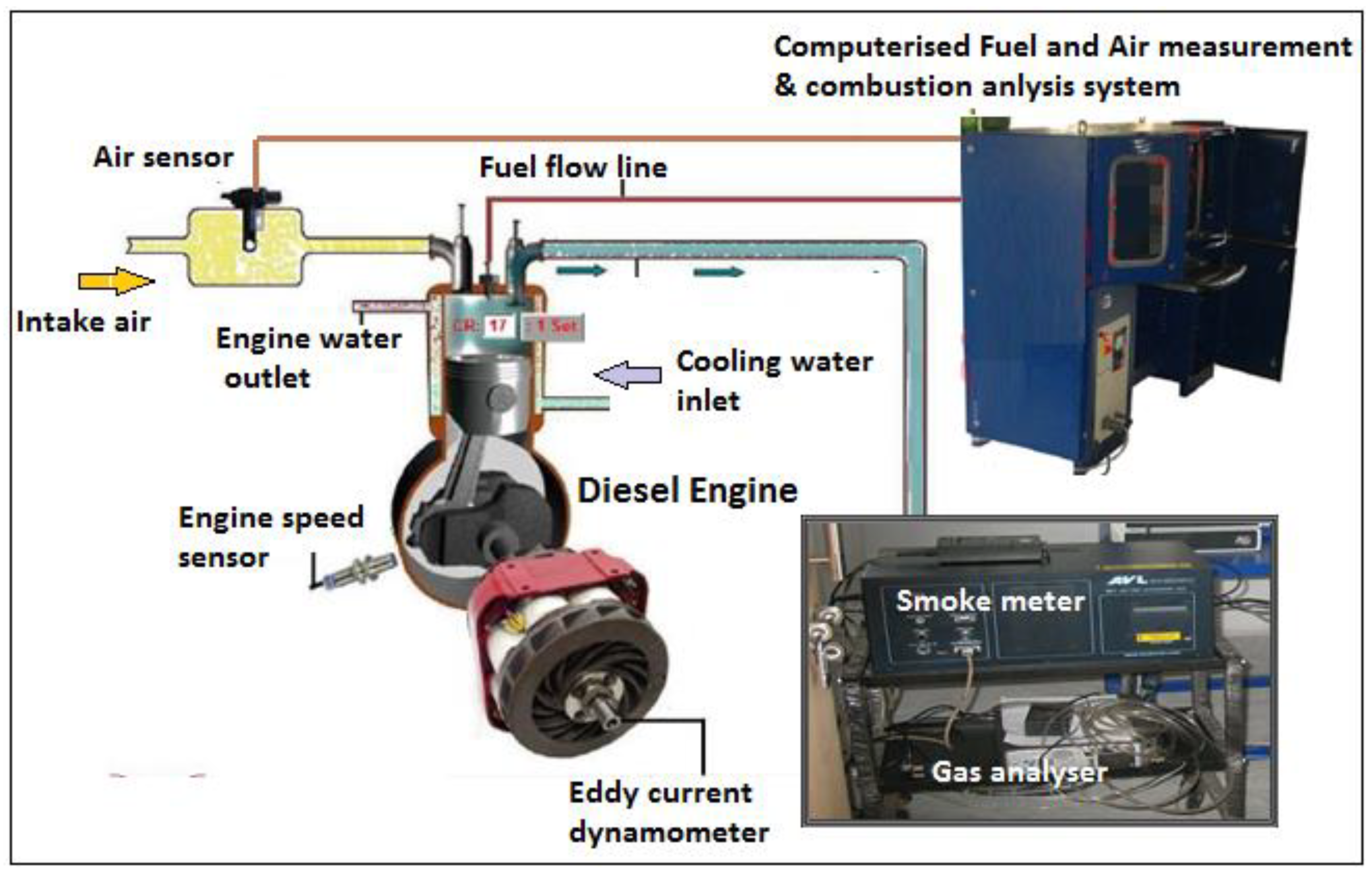
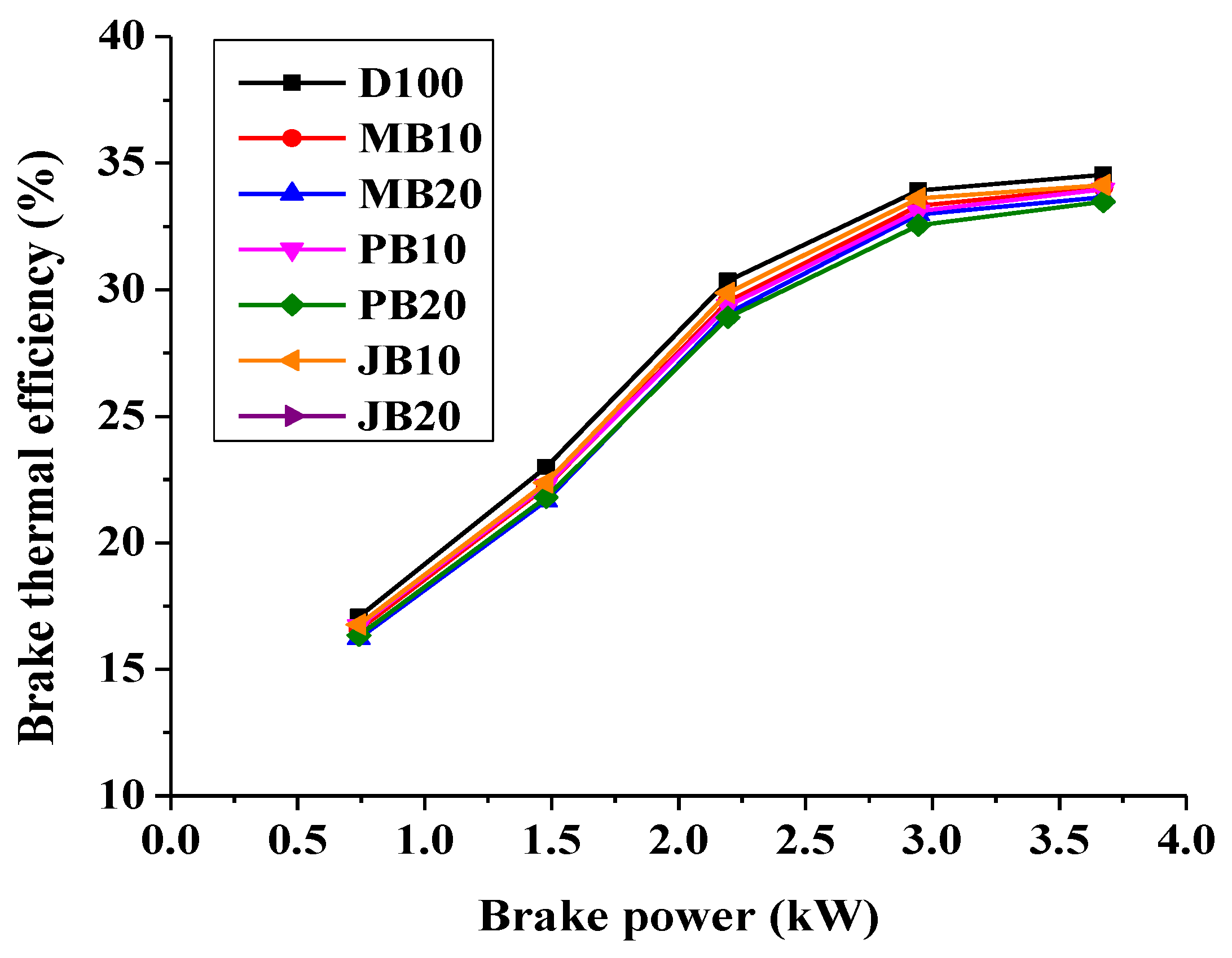
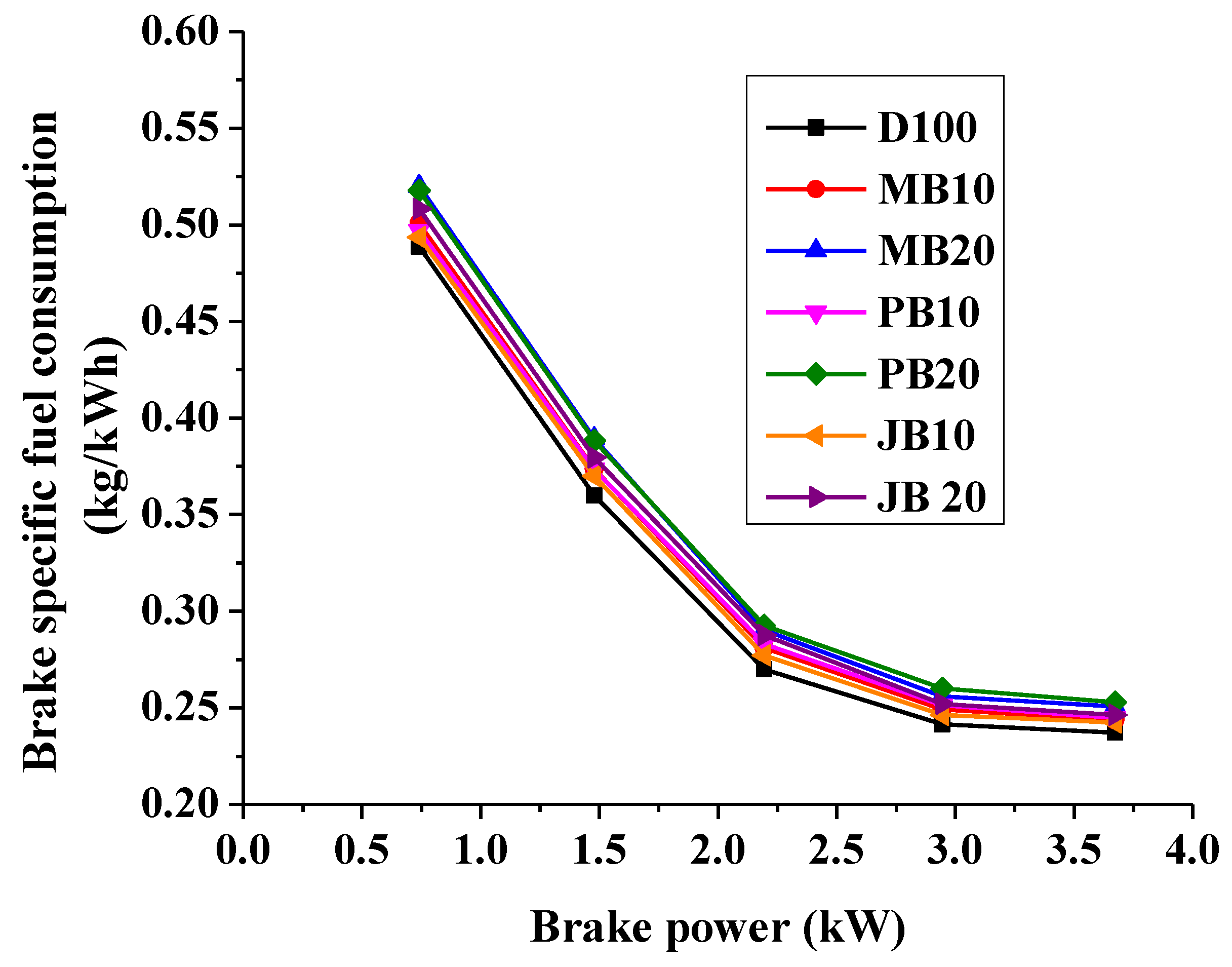
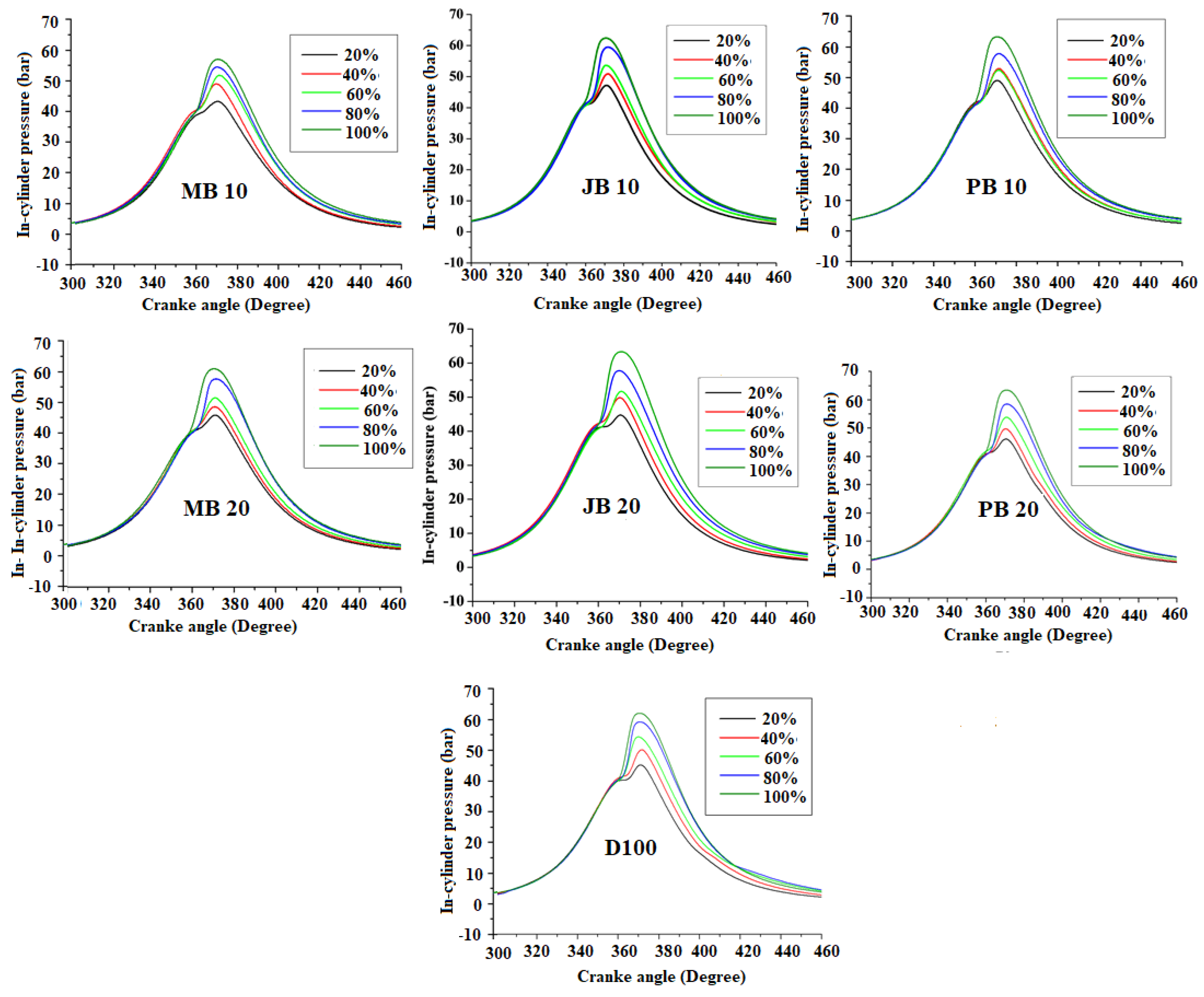

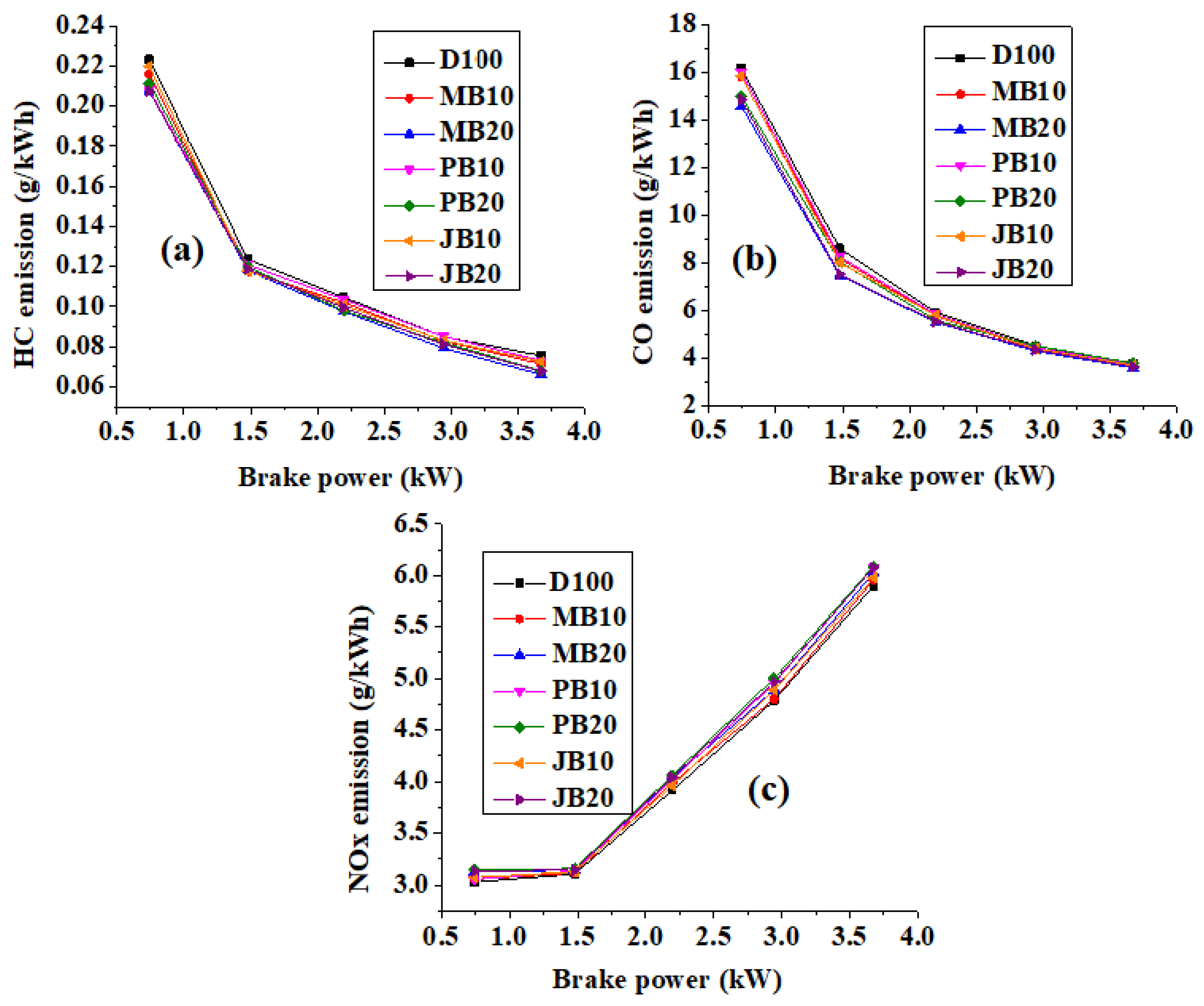
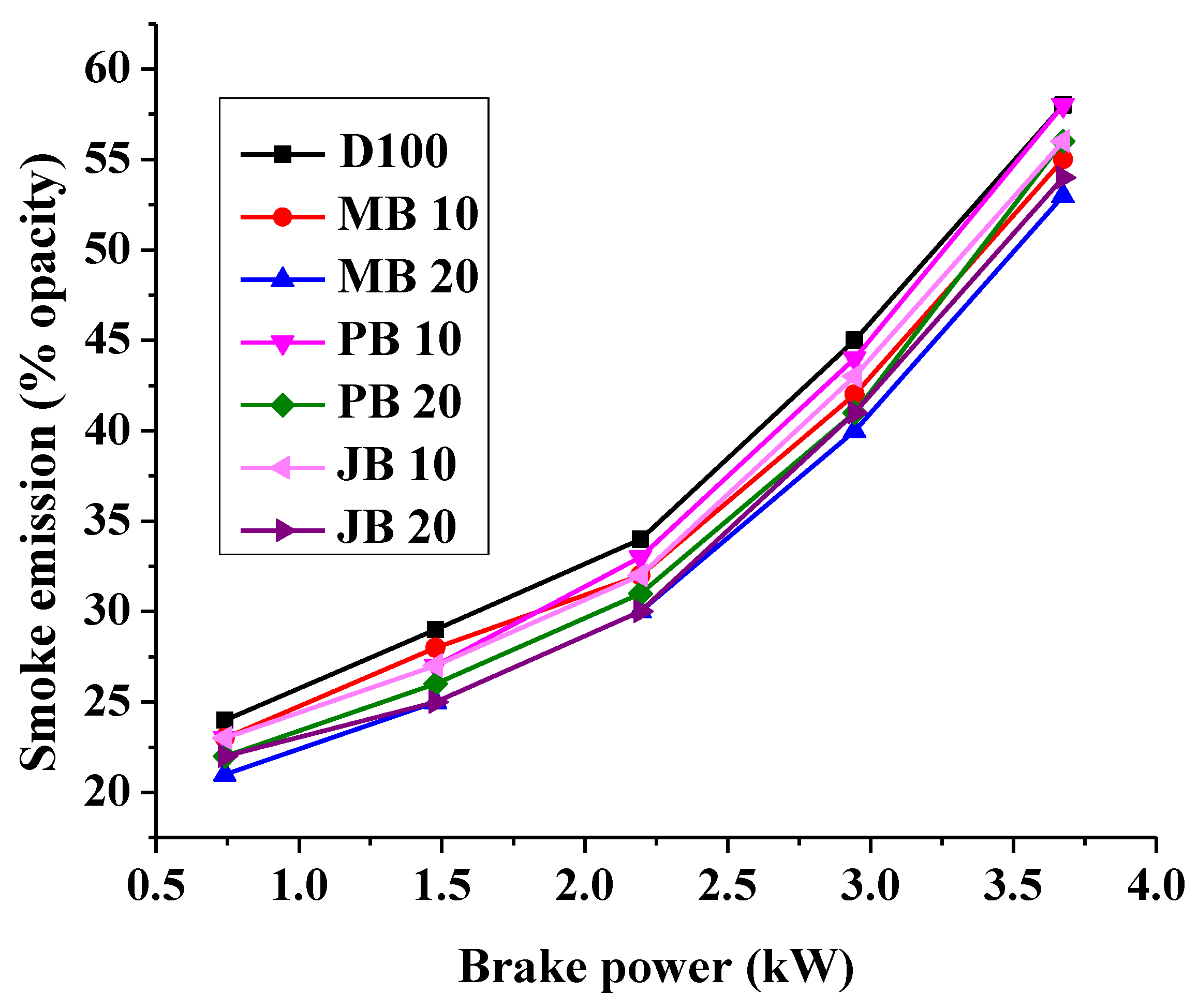
| S. No | Parameters | Jatropha Oil | Polanga Oil | Microalgae Oil | |||
|---|---|---|---|---|---|---|---|
| 1st Stage | 2nd Stage | 1st Stage | 2nd Stage | 1st Stage | 2nd Stage | ||
| 1 | Oil/lipid (mL) | 250.0 | 276.5 | 250,0 | 268.4 | 250.0 | 265.1 |
| 2 | Methanol (in %, v/v of oil) | 50.0 | 25.0 | 50.0 | 25.0 | 50.0 | 25.0 |
| 3 | Co-solvent (Toluene, % v/v) | 1.0 | - | 1.0 | - | 1.0 | - |
| 5 | Acid catalyst (Sulphuric acid, in %, v/v) | 0.25 | - | 1.50 | - | 2.00 | - |
| 6 | Base catalyst (Potassium hydroxide in%, wt/v) | - | 0.9 | - | 1.1 | - | 1.5 |
| 7 | Reaction temperature (°C) | 64 | 65 | 64 | 65 | 64 | 65 |
| 8 | Reaction duration (min) | 7 | 6 | 10 | 8 | 12 | 15 |
| 9 | Microwave power (watt) | 700 | 700 | 700 | 700 | 700 | 700 |
| 10 | Settling time (min) | 45 | 70 | 45 | 70 | 45 | 70 |
| 11 | Results | ||||||
| (a) Byproduct + impurities (glycerol + excess methanol + excess catalyst + gum), in mL | 25.5 ± 2 | - | 32.6 ± 2 | - | 35.9 ± 2 | 68.3 ± 2 | |
| (b) Methanol recovered | - | 36 ± 3 | - | 33.7 ± 3 | - | nd | |
| (c) Glycerol recovered (mL) | - | 18 ± 2 | - | 15 ± 2 | - | nd | |
| 13 | Biodiesel Yield (in mL) | - | 241.4 | - | 236.8 | - | 219.0 |
| 14 | Final biodiesel Yield (%) | 96.5 ± 3 | 94.7 ± 4 | 87.6 ± 3 | |||
| Parameters | Test Method | Diesel | MB10 | MB20 | JB10 | JB20 | PB10 | PB20 | MB100 | JB100 | PB100 | Error Analysis |
|---|---|---|---|---|---|---|---|---|---|---|---|---|
| Density at 15 °C (kg/m3) | ASTM-D 4052 | 830.1 | 833.5 | 835.2 | 832.8 | 835.1 | 834.1 | 836.9 | 889.0 | 878.0 | 883.0 | ±0.5% |
| Viscosity at 40 °C (mm2/s) or cSt | ASTM-D 445 | 2.85 | 2.91 | 2.99 | 2.92 | 3.01 | 2.94 | 3.03 | 4.87 | 4.98 | 5.24 | ±0.5% |
| Pour point (°C) | ASTM-D 97 | −2 | −3 | −3 | 2 | −1 | 4 | −1 | −4 | 1 | 3 | ±1% |
| Flash point (°C) | ASTM-D 93 | 57 | 88 | 101 | 90 | 108 | 89 | 120 | 154 | 162 | 158 | ±1% |
| Copper strip corrosion | ASTM-D 130 | 1 | 1 | 1 | 1 | 1 | 1 | 1 | 1 | 1 | 1 | - |
| Calorific value (MJ/kg) | ASTM-D 130 | 43.94 | 43.34 | 42.74 | 43.71 | 43.01 | 43.23 | 42.52 | 38.94 | 36.94 | 38.08 | ±3% |
| Oxidation stability (IP, at 140 °C, h) | ASTM D 240-09 | Not determined | 16.3 | 7.3 | 18.3 | 8.6 | 14.8 | 6.9 | 4.5 | 3.7 | 3 | ±0.5% |
| Water content | ASTM D-2709 | 0.002 | 0.005 | 0.018 | 0.06 | 0.19 | 0.07 | 0.19 | 0.12 | 0.11 | 0.12 | ±0.5% |
| Fatty Acid Composition (%) | Carbon Structure | Composition | ||
|---|---|---|---|---|
| Microalgae Biodiesel | Jatropha Biodiesel | Polanga Biodiesel | ||
| Capric acid | C10.0 | 0.83 | - | - |
| Lauric acid | C12.0 | 0.21 | - | - |
| Myristic acid | C14.0 | 2.04 | - | - |
| Palmitic acid | C16:0 | 21.26 | 15.87 | 11.97 |
| Palmitoleic acid | C16:1 | 9.86 | 2.87 | 1.08 |
| Stearic acid | C18:0 | 6.86 | 7.86 | 13.23 |
| Oleic acid | C18:1 | 26.78 | 42.16 | 33.87 |
| Linoleic acid | C18:2 | 31.08 | 32.14 | 36.34 |
| Linolenic acid | C18:3 | 6.89 | 1.34 | 0.9 |
| Arachidic acid | C20.0 | 0.29 | - | - |
| Erucic acid | C22.1 | 2.18 | - | - |
| Saturated Fatty acids | 28.49 | 23.73 | 26.90 | |
| Monounsaturated fatty acids | 35.44 | 42.03 | 34.95 | |
| Polyunsaturated fatty acids | 35.97 | 33.48 | 37.24 | |
| Particulars | Specifications |
|---|---|
| Engine type | Single cylinder, four stroke, water cooled, direct injection compression engine |
| Bore x Stroke | 80 × 110 mm |
| Cubic capacity | 0.533 L |
| Compression ratio | 16.5:1 |
| Rated speed (rpm) | 1500 |
| Power | 3.7 kW |
| Specific fuel consumption | 245 g/kWh |
| Test Trails | Fuel Used | Engine Load | Measurements |
|---|---|---|---|
| Trail 1 | Diesel | 20% load: 0.7 kW 40% load: 1.5 kW 60% load: 2.2 kW 80% load: 2.9 kW 100% load: 3.7 kW | Performance parameters: Fuel consumption, Brake power Combustion parameters: In-cylinder pressure versus crank angle (CA) degrees Emission parameters: CO, HC, NOx and Smoke emissions |
| Trail 2 | MB10, MB20 | ||
| Trail 3 | JB10, JB20 | ||
| Trail 4 | PB10, PB20 |
| Instrument/Sensor Name | Measuring Parameter | Measuring Range | Resolution | Accuracy | Uncertainty (%) |
|---|---|---|---|---|---|
| NDIR analyzer | CO emission (by volume) | 0–10% | 0.01% | ±0.03% | 2.86 |
| HC emission (ppm) | 0–10.000 | 1 | ±10 | 2.56 | |
| NOx emission (ppm) | 0–5.000 | 1 | <1000 ppm ± 5 ppm ≥1000 ppm ± 5% of value | 2.692 | |
| Smoke meter | Smoke emission (%) | 0–100% Opacity | 0.1% Opacity | ±1% of value | 2.512 |
| BP | ±2.2% | ||||
| BTE | ±1.29% |
© 2020 by the authors. Licensee MDPI, Basel, Switzerland. This article is an open access article distributed under the terms and conditions of the Creative Commons Attribution (CC BY) license (http://creativecommons.org/licenses/by/4.0/).
Share and Cite
Sharma, A.K.; Sharma, P.K.; Chintala, V.; Khatri, N.; Patel, A. Environment-Friendly Biodiesel/Diesel Blends for Improving the Exhaust Emission and Engine Performance to Reduce the Pollutants Emitted from Transportation Fleets. Int. J. Environ. Res. Public Health 2020, 17, 3896. https://doi.org/10.3390/ijerph17113896
Sharma AK, Sharma PK, Chintala V, Khatri N, Patel A. Environment-Friendly Biodiesel/Diesel Blends for Improving the Exhaust Emission and Engine Performance to Reduce the Pollutants Emitted from Transportation Fleets. International Journal of Environmental Research and Public Health. 2020; 17(11):3896. https://doi.org/10.3390/ijerph17113896
Chicago/Turabian StyleSharma, Amit Kumar, Pankaj Kumar Sharma, Venkateswarlu Chintala, Narayan Khatri, and Alok Patel. 2020. "Environment-Friendly Biodiesel/Diesel Blends for Improving the Exhaust Emission and Engine Performance to Reduce the Pollutants Emitted from Transportation Fleets" International Journal of Environmental Research and Public Health 17, no. 11: 3896. https://doi.org/10.3390/ijerph17113896
APA StyleSharma, A. K., Sharma, P. K., Chintala, V., Khatri, N., & Patel, A. (2020). Environment-Friendly Biodiesel/Diesel Blends for Improving the Exhaust Emission and Engine Performance to Reduce the Pollutants Emitted from Transportation Fleets. International Journal of Environmental Research and Public Health, 17(11), 3896. https://doi.org/10.3390/ijerph17113896






